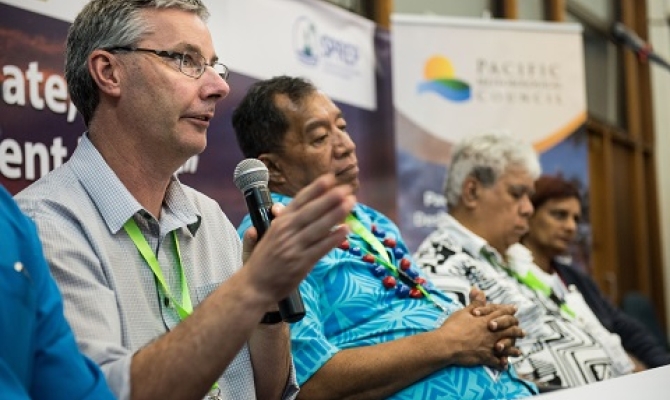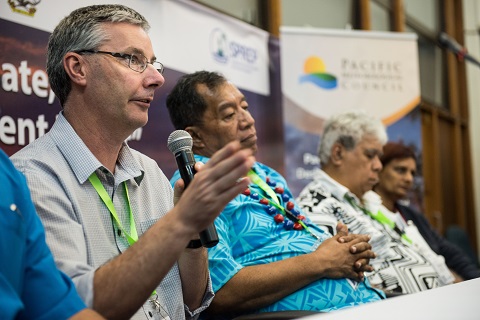
Climate Change Resilience
By Priya Chand Islands Business Magazine & Pita Ligaiula PACNEWS, in Honiara, Solomon Islands
15 August, 2017, Honiara, Solomon Islands, PMC-4 – A virtual Pacific Island Regional Climate Center (PIRCC) is being proposed for the region and is expected to be endorsed by the Pacific Meteorological Council tomorrow.
Formally known as the World Meteorological Organization Regional Association-V Pacific Islands Regional Climate Centre (WMO RA-V PIRCC), the center will generate and deliver more regionally-focused high-resolution data and products.
Chair of the Pacific Islands Climate Services Panel (PICS) and member of RA V Working Group on Climate Services (WG-CLS), Dr. Andrew Tait said the regional climate center will particularly target meteorological services in accessing information across the entire region so that countries have the data to be more aware of what is happening around them.
Tait said remote Pacific Island Countries in particular could benefit from the center and would be able to have an overview on the state of climate on a regional scale.
"It is difficult sometimes for a country in the Pacific Islands to fully appreciate what's happening beyond their own borders, and beyond their own oceans. For example, what the current level sea temperatures are across the entire region, and how that might influence my country," he said.
"In fact, regional climate centers are a major initiative across the world so there are already established climate centers in South America, Asia, Europe for instance. So we wanted to have one for the Pacific Islands region as well."
The proposed center is expected to contribute information and resources on the current state of the climate, on the current state of the ocean conditions, forecasts for rainfall and temperature for the next season, how to manage climate data, as well as climate change predictions for the region.
It will receive contribution from the likes of organizations such as the National Ocean and Atmospheric Administration (NOAA), Bureau of Meteorology in Australia, National Institute of Water and Atmospheric Research (NIWA) in New Zealand and other institutes and organizations in the region.
The work on the center began three years ago, and if all goes well, the center could be established by the end of 2017, and go through a demonstration phase for a couple of years. – #PMC4 #PacificMet
The Fourth Pacific Meteorological Council is being held in Honiara, Solomon Islands from the 14 – 17 August co-hosted by the government of Solomon Islands, the Secretariat of the Pacific Regional Environment Programme (SPREP) and World Meteorological Organization (WMO). This will followed by the Second Pacific Meteorological Ministers Meeting (PMMM) on the 18 of August.
The PMC and PMMM is supported by the Government of Solomon Islands, SPREP, WMO, Government of Australia through the Climate and Oceans Support Programme (COSPPac) and Pacific Australia Climate Change Science and Adaptation Planning Programme (PACCSAP), Government of Finland, National Ocean and Atmospheric Administration (NOAA), United Nations Development Programme through the Resilience in the Pacific (SIDS) project.
The PMC consists of members of the Pacific National Meteorological and Hydrological Services supported by its technical partners, regional organisations, non-government organisations and private sectors.
This article was developed by a Pacific Media Team of Reporters currently providing coverage on the Fourth Pacific Meteorological Council in Solomon Islands. This activity coordinated by SPREP is supported by a partnership between the Government of Solomon Islands, SPREP, Australia funded project (Climate and Oceans Support Program (COSPPac) and UNDP Disaster for Pacific SIDS (RESPAC) project.
The views and opinions expressed in this article are those of the writer and do not necessarily reflect the views of the Secretariat of the Pacific Regional Environment Programme (SPREP) or the United Nations Development Programme (UNDP)both of which provided funding for generating media articles.
15 August, 2017, Honiara, Solomon Islands, PMC-4 – A virtual Pacific Island Regional Climate Center (PIRCC) is being proposed for the region and is expected to be endorsed by the Pacific Meteorological Council tomorrow.
Formally known as the World Meteorological Organization Regional Association-V Pacific Islands Regional Climate Centre (WMO RA-V PIRCC), the center will generate and deliver more regionally-focused high-resolution data and products.
Chair of the Pacific Islands Climate Services Panel (PICS) and member of RA V Working Group on Climate Services (WG-CLS), Dr. Andrew Tait said the regional climate center will particularly target meteorological services in accessing information across the entire region so that countries have the data to be more aware of what is happening around them.
Tait said remote Pacific Island Countries in particular could benefit from the center and would be able to have an overview on the state of climate on a regional scale.
He said while work is being done on a global scale from climate models and data sets on a global and national scale, there is a missing link at the regional scale "so we hoped this climate center would fill that gap and provide a regional perspective across the entire Pacific Islands region."
PICS Panel Chair, Dr. Andrew Tait

PICS Panel Chair, Dr. Andrew Tait
"It is difficult sometimes for a country in the Pacific Islands to fully appreciate what's happening beyond their own borders, and beyond their own oceans. For example, what the current level sea temperatures are across the entire region, and how that might influence my country," he said.
"In fact, regional climate centers are a major initiative across the world so there are already established climate centers in South America, Asia, Europe for instance. So we wanted to have one for the Pacific Islands region as well."
The proposed center is expected to contribute information and resources on the current state of the climate, on the current state of the ocean conditions, forecasts for rainfall and temperature for the next season, how to manage climate data, as well as climate change predictions for the region.
It will receive contribution from the likes of organizations such as the National Ocean and Atmospheric Administration (NOAA), Bureau of Meteorology in Australia, National Institute of Water and Atmospheric Research (NIWA) in New Zealand and other institutes and organizations in the region.
The work on the center began three years ago, and if all goes well, the center could be established by the end of 2017, and go through a demonstration phase for a couple of years. – #PMC4 #PacificMet
The Fourth Pacific Meteorological Council is being held in Honiara, Solomon Islands from the 14 – 17 August co-hosted by the government of Solomon Islands, the Secretariat of the Pacific Regional Environment Programme (SPREP) and World Meteorological Organization (WMO). This will followed by the Second Pacific Meteorological Ministers Meeting (PMMM) on the 18 of August.
The PMC and PMMM is supported by the Government of Solomon Islands, SPREP, WMO, Government of Australia through the Climate and Oceans Support Programme (COSPPac) and Pacific Australia Climate Change Science and Adaptation Planning Programme (PACCSAP), Government of Finland, National Ocean and Atmospheric Administration (NOAA), United Nations Development Programme through the Resilience in the Pacific (SIDS) project.
The PMC consists of members of the Pacific National Meteorological and Hydrological Services supported by its technical partners, regional organisations, non-government organisations and private sectors.
This article was developed by a Pacific Media Team of Reporters currently providing coverage on the Fourth Pacific Meteorological Council in Solomon Islands. This activity coordinated by SPREP is supported by a partnership between the Government of Solomon Islands, SPREP, Australia funded project (Climate and Oceans Support Program (COSPPac) and UNDP Disaster for Pacific SIDS (RESPAC) project.
The views and opinions expressed in this article are those of the writer and do not necessarily reflect the views of the Secretariat of the Pacific Regional Environment Programme (SPREP) or the United Nations Development Programme (UNDP)both of which provided funding for generating media articles.